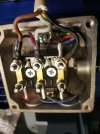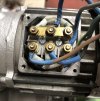I'm here in France with a motor that I want to power
I have standard 230V single phase line power
I bought a VFD to power the motor -
1 hp VFD, 1-Phase 220V to 3-Phase 380V VFD
Input Voltage (Single phase): 220~230V
Output Voltage (Three phase): 380V
Here's the motor windings/wiring
Do I leave the motor as Star or switch to Delta?
It's currently setup as Star.
I've been told Star by someone and Delta by someone else
so which one and why?



I have standard 230V single phase line power
I bought a VFD to power the motor -
1 hp VFD, 1-Phase 220V to 3-Phase 380V VFD
Input Voltage (Single phase): 220~230V
Output Voltage (Three phase): 380V
Here's the motor windings/wiring
Do I leave the motor as Star or switch to Delta?
It's currently setup as Star.
I've been told Star by someone and Delta by someone else
so which one and why?










